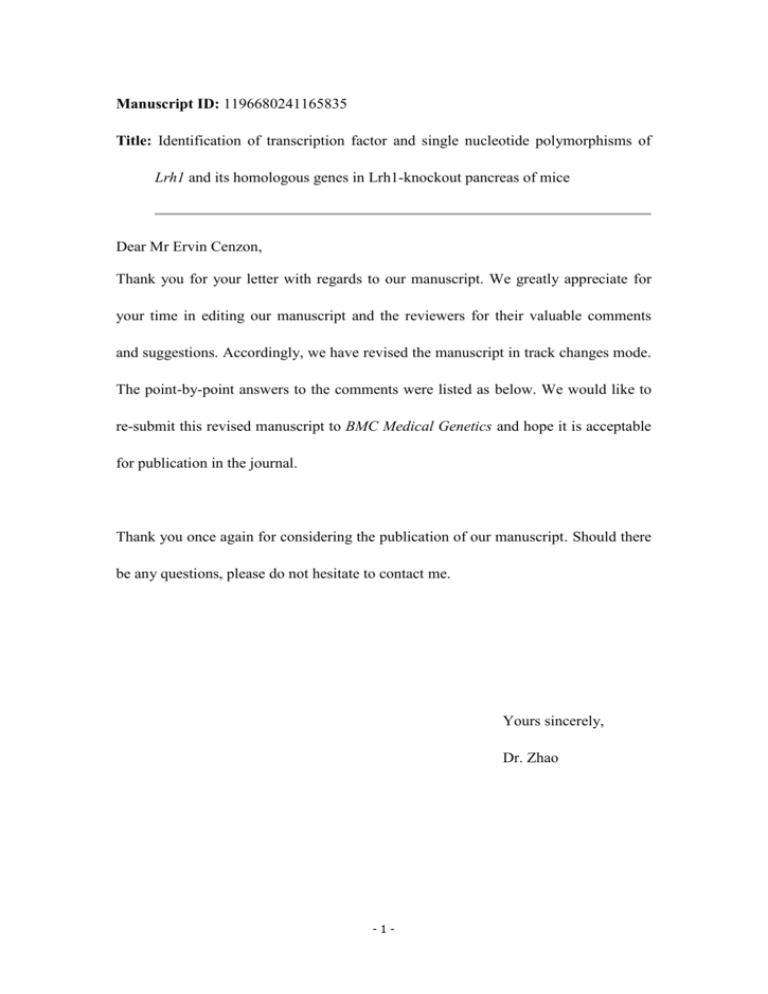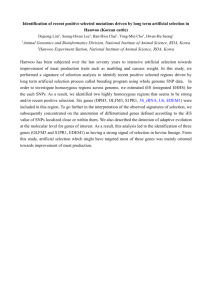Manuscript ID: 1196680241165835 Title: Identification of
advertisement

Manuscript ID: 1196680241165835 Title: Identification of transcription factor and single nucleotide polymorphisms of Lrh1 and its homologous genes in Lrh1-knockout pancreas of mice Dear Mr Ervin Cenzon, Thank you for your letter with regards to our manuscript. We greatly appreciate for your time in editing our manuscript and the reviewers for their valuable comments and suggestions. Accordingly, we have revised the manuscript in track changes mode. The point-by-point answers to the comments were listed as below. We would like to re-submit this revised manuscript to BMC Medical Genetics and hope it is acceptable for publication in the journal. Thank you once again for considering the publication of our manuscript. Should there be any questions, please do not hesitate to contact me. Yours sincerely, Dr. Zhao -1- Response to the Reviewer 1’ comments: Manuscript ID: 1196680241165835 Title: Identification of transcription factor and single nucleotide polymorphisms of Lrh1 and its homologous genes in Lrh1-knockout pancreas of mice General comments: We would like to thank you for your comments that are of great help for the revision. Accordingly, we have revised the manuscript in track changes mode. The point-bypoint answers were listed as below. (Comment 1) The number of DEGs (15,683) seems too many. I suggest the authors to use a different tool to call DEGs again, such as edgeR available in R or Bioconductor. (Response 1) Thanks for your comment. We used NOISeq in R to screen the DEGs between Lrh1 pancreas knockout mice and wild type samples. A FDR value less than 0.001 was chosen as the threshold. The homologous genes of Lrh1 were selected in the screened DEGs. The main aim of the study was to identify TFs and SNPs of Lrh1 and its homologous genes. If edgeR was used to screen the DEGs, the potential homologous genes which function in the Lrh1-related secretion of pancreatic fluid may be missed. All the identified homologous genes should be investigated via experimental studies in the future. We hope that our explanation is acceptable. -2- (Comment 2) It is not clear of the meaning of homology genes here. What is the definition? Usually it refers to a gene with same functions among human and mouse or other species. (Response 2) Thanks for your comment. Definition of homology genes in our manuscript have been added as follows: “Homology genes here refer to the paralogous genes which share a high degree of sequence similarity (maximum expectation value was set to e-5) with Lrh1 in mice.” (Comment 3) For the SNPs analysis, the authors need to look at publicly available SNP databases to identify how many diseased SNPs relevant to the regions of genes or their de novo discovered SNPs. This may reveal more important biological meanings. (Response 3) Thanks for your comments. We totally agree with your comments. Accordingly, we searched the identified SNPs in the dbSNP database to identify diseased SNPs or de novo discovered SNPs. However, neither diseased SNPs nor de novo discovered SNPs were found. -3- Response to the Reviewer 2’ comments: Manuscript ID: 1196680241165835 Title: Identification of transcription factor and single nucleotide polymorphisms of Lrh1 and its homologous genes in Lrh1-knockout pancreas of mice General comments: We would like to thank you for your comments that are of great help for the revision. Accordingly, we have revised the manuscript in track changes mode. The point-bypoint answers were listed as below. (Comment 1) The sentence: “…and its homology genes provided the candidate mutant sites might affect the regulation…” in Abstract and page 9 line 3 has grammar problem, please revise it. (Response 1) Thanks for your comments. The sentence has been changed to “Furthermore, the SNPs analysis of Lrh1 and its homology genes provided the candidate mutant sites that might affect the Lrh1-related production and secretion of pancreatic fluid.” (Comment 2) The “Lrh1” page 4 line 20 should be “Lrh1” (Response 2) Thanks for your comments. Do you mean that “including 2 Lrh1 pancreas knockout samples” should be “including 2 Lrh1 pancreas knockout samples”? We have changed “Lrh1” to “Lrh1”. -4- (Comment 3) The authors use “Lrh1” in first part, however, “Nr5a2” is used in later parts. In my opinion, it is better to unify the name of “Lrh1” or “Nr5a2” in the whole manuscript. (Response 3) Thanks for your comments. The name has been unified as “Lrh1” throughout the manuscript. (Comment 4) The sentence: “…total 1819 SNPs of Phkb was intron type and 1343 SNPs was upstream type that was nearly 68% of…” in page 7 line 7 has grammar problem, please revise it. Apart from it, the “was” in the sentence should be “were”. (Response 4) Thanks for your comments. The sentence has been changed to “Meanwhile, total 1819 SNPs of Phkb were located in the intron and 1343 SNPs were located in the upstream region of Phkb.” (Comment 5) In Discussion, the authors use “FTF” and “FTF”, please unified it (Response 5) Thanks for your comments. Do you mean that “fetoprotein TF” and “FTF” should be unified? We have unified it to ‘’FTF”. (Comment 6) The references should be added in sentence “Many literatures have elucidated the function of Lrh1/ Nr5a2/ FTF/CYP7A …” in page 7 line 13, and “Out C et al. have suggested that CYP7A1 expression…” in page 8 line 6. (Response 6) Thanks for your comments. Accordingly, we added the references. -5-






